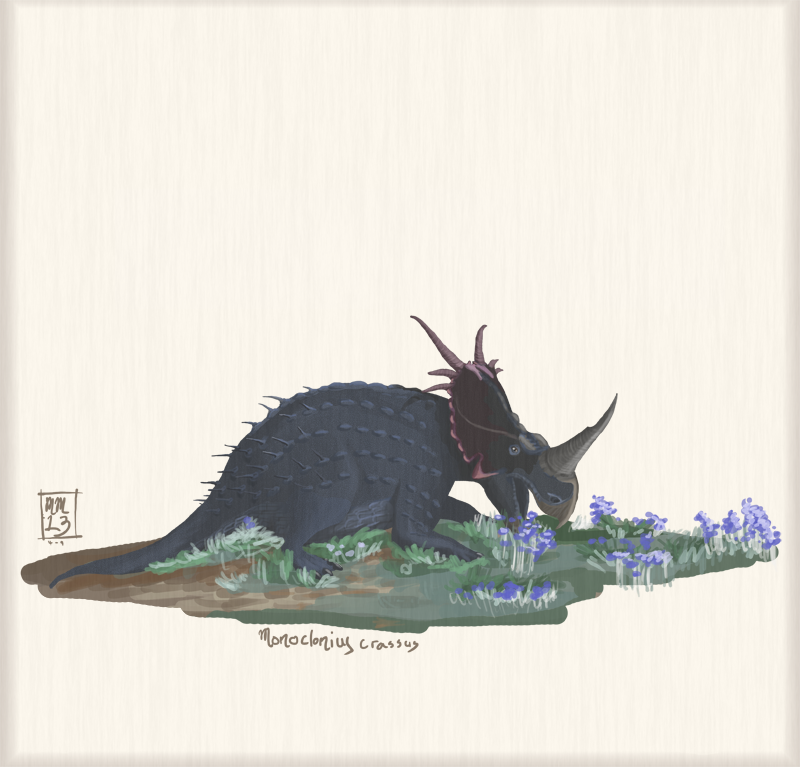home > natural history
Monoclonius crassus
"solid single sprout"

Monoclonius crassus is an iconic ceratopsian which owes its status almost completely to another species. Originally known only from teeth and a fragmentary frill and nasal horn, the Monoclonius was one of the first ceratopsians known to science, found by E.D. Cope in 1976, but, like many of Cope's species, it was not recognized for what it really was (a "horned dinosaur") until more complete remains from other species like Triceratops horridus were found by Cope's rival O.C. Marsh. Monoclonius itself remaned enigmatic for many years, though the idea of a Triceratops-like ceratopsian with a single nasal horn was used by Charles R. Knight in his famous painting of Cope's other dubious ceratopsian, Agathaumas. Knight also incorporated dermal spiny dermal armor associated with some supposed Monoclonius remains, though at least some of this material was later shown to belong to ankylosaurs and pachycephalosaurs.
Monoclonius became iconic when complete skeletons ofceratopsians were found in the Judith River/Dinosaur Park Formation of Montana/Alberta. In the early 1900s, C.H. Sternberg (who had co-discovered the orgiinal Monoclonius fossils with Cope) established that complete specimens classified by Lawrence Lambe as Centrosaurus apertus (and some of which were considered to be Monoclonius and which had already been used to form a picture of that animal) were a distinct species. After this, the genus Monoclonius was dismantled, with former specimens re-assigned to either new or recently established centrosaurine genera.
Matters were complicated by the discovery of the drastic changes centrosaurines went through as they grew, and today the distinctive Monoclonius specimens are generally considered juvenile centrossaurines. The long, generally flattened frill with larger incipient spikes at the first three positions of the the parietal are reminiscant of Styracosaurus and Einiosaurus, both of about the same geological age. The large size of a specimen sometimes referred to the distinct species Monoclonius lowei compares with some pachyrhinosaurins like the contemporary Achelousaurus, and while these do begin life with a small nasal horn that later develops into a boss, it isn't backward-cureved. It may be that Monoclonius is a juvenile form of (and therefore a senior synonym of) one of these centrosaurines, it may be a valid species similar to both, possibly a transitional form between centrosaurin-type centrosaurs and pachyrhinosaurs. In my restoration of a hypothetical, mature Monoclonius above, I made it generally styracosaur-like, though with more einiosaur-like parietal spikes though these could alternately be seen as styracosaur parietal spikes which are not yet fully grown. In this way I've tried to hedge my bets: this Monoclonius could either be a mature, intermediate stage between styracosaurs and einiosaurs, or simply an immature styracosaur.
Image Details:
Media: Photoshop CS5 and Wacom Bamboo
License:
ALL RIGHTS RESERVED
DESCRIPTION
Length: ~5.5m (18ft)
Weight: ~2.7t
Location: Dinosaur Park Formation, Montana
Time: Campanian age, Late Cretaceous (75ma)
CLASSIFICATION
Kingdom: Animalia
Phylum: Chordata
Class: Stem-Aves
Order: Ornithischia
Family: Ceratopsidae
Genus: Monoclonius
Species: M. crassus
SYSTEMATICS
Sauropsida
Diapsida
Archosauria
Ornithosuchia
Dinosauria
Ornithischia
Ceratopsidae